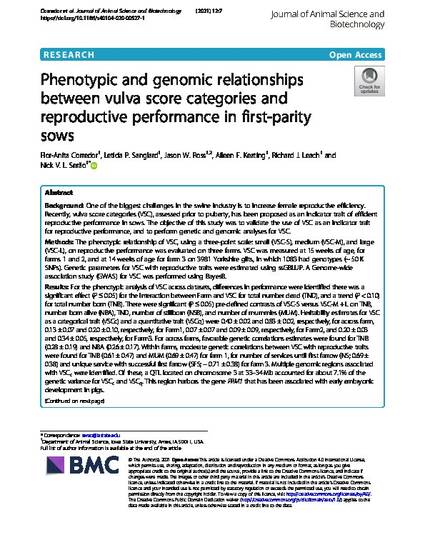
Background: One of the biggest challenges in the swine industry is to increase female reproductive efficiency. Recently, vulva score categories (VSC), assessed prior to puberty, has been proposed as an indicator trait of efficient reproductive performance in sows. The objective of this study was to validate the use of VSC as an indicator trait for reproductive performance, and to perform genetic and genomic analyses for VSC.
Methods: The phenotypic relationship of VSC, using a three-point scale: small (VSC-S), medium (VSC-M), and large (VSC-L), on reproductive performance was evaluated on three farms. VSC was measured at 15 weeks of age, for farms 1 and 2, and at 14 weeks of age for farm 3 on 3981 Yorkshire gilts, in which 1083 had genotypes (~ 50 K SNPs). Genetic parameters for VSC with reproductive traits were estimated using ssGBLUP. A Genome-wide association study (GWAS) for VSC was performed using BayesB.
Results: For the phenotypic analysis of VSC across datasets, differences in performance were identified there was a significant effect (P ≤ 0.05) for the interaction between Farm and VSC for total number dead (TND), and a trend (P < 0.10) for total number born (TNB). There were significant (P ≤ 0.05) pre-defined contrasts of VSC-S versus VSC-M + L on TNB, number born alive (NBA), TND, number of stillborn (NSB), and number of mummies (MUM). Heritability estimates for VSC as a categorical trait (VSCc) and a quantitative trait (VSCq) were 0.40 ± 0.02 and 0.83 ± 0.02, respectively, for across farm, 0.13 ± 0.07 and 0.20 ± 0.10, respectively, for Farm1, 0.07 ± 0.07 and 0.09 ± 0.09, respectively, for Farm2, and 0.20 ± 0.03 and 0.34 ± 0.05, respectively, for Farm3. For across farms, favorable genetic correlations estimates were found for TNB (0.28 ± 0.19) and NBA (0.26 ± 0.17). Within farms, moderate genetic correlations between VSC with reproductive traits were found for TNB (0.61 ± 0.47) and MUM (0.69 ± 0.47) for farm 1, for number of services until first farrow (NS; 0.69 ± 0.38) and unique service with successful first farrow (SFS; − 0.71 ± 0.38) for farm 3. Multiple genomic regions associated with VSCc were identified. Of these, a QTL located on chromosome 3 at 33–34Mb accounted for about 7.1% of the genetic variance for VSCc and VSCq. This region harbors the gene PRM1 that has been associated with early embryonic development in pigs.
Conclusions: The results support potential of VSC for improved reproductive efficiency on first-parity performance, but the results might depend on the interaction between environmental factors and VSC, as well as potentially additive genetics.
Available at: http://works.bepress.com/aileen-keating/47/

This article is published as Corredor, FA., Sanglard, L.P., Ross, J.W. et al. Phenotypic and genomic relationships between vulva score categories and reproductive performance in first-parity sows. J Animal Sci Biotechnol 12, 7 (2021). doi: 10.1186/s40104-020-00527-1.